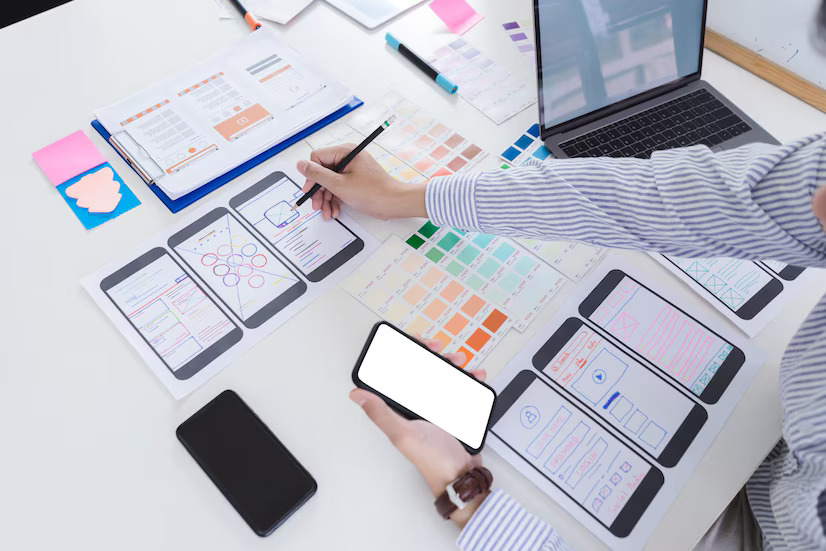What exactly separates a smooth, intuitive digital product from one that feels like it was built in a rush? Every great user experience is backed by a smart, thoughtful process. And if you’re working with a UI/UX design services company, that process better be airtight.
You’ve probably interacted with apps that feel natural. You don’t think. You just do. That’s no accident. That’s what happens when a UI/UX design services company builds systems around how people think, not just how things look.
In this piece, we’ll walk through the top eight features a strong design process must include. Not optional. Not “nice to have.” These are essentials. Whether you’re building something from scratch or redesigning an existing experience, this is the checklist your team, or your agency, must tick. Let’s dig in.
Why Should A UI/UX Design Process Be Structured?
It’s tempting to jump into visuals right away. Sketch something. Pick colors. Maybe throw together a homepage. But hold up, if there’s no system, you’ll end up redesigning things five times over.
A smart UI/UX design services company builds its process like scaffolding. Research holds up the wireframes. Wireframes feed into the visuals. Visuals turn into usable interfaces. Each phase feeds the next. But what if the structure is missing? That’s when bugs happen. Users get lost. Conversions drop. It’s a mess. That’s why process matters. It’s the difference between “It looks cool” and “It works beautifully.”
Let’s walk through what that process should actually look like.
User Research Needs To Come First, Always
Before you design anything, you need to know who you’re designing for. This is where everything begins for a solid UI/UX design services company. They start by asking: Who are the users? What are they trying to do? What’s stopping them? User research is more than just a survey. It’s watching behavior. Asking questions. Listening, not assuming.
A smart team will use multiple methods here. Interviews, analytics, heatmaps, stakeholder discussions, all of it feeds into one goal: understanding the user deeply. If this step is skipped or rushed, it shows later in clunky design decisions and confusing flows. Now, once research is in hand, they translate all those insights into personas. These aren’t made-up characters. They’re real, behavior-based archetypes that drive every design choice going forward.
Only after all of this does the actual design phase start. And honestly? That’s how it should be.
Why Journey Mapping Helps Connect The Dots
Ever opened an app and thought, “Where am I supposed to go next?” That’s a journey map failure. When a UI/UX design services company invests in journey mapping, they’re outlining every step a user takes, from start to finish. From opening the homepage to completing a goal like making a purchase or submitting a form.
But here’s the important part: journey maps are not idealized dreams. They’re based on real behavior. They highlight where users get frustrated, where they drop off, and where they succeed. Done right, a journey map reveals the emotional and functional experience of a user interacting with your product. It exposes pain points early, before they turn into complaints or churn.
Once that map is created, the design team can align user goals with business goals. The two don’t have to be at odds. But without mapping, they usually are. If your UI/UX design services company isn’t mapping journeys, that’s a red flag. You’re building blind.
Wireframing Helps You Focus On Function Over Fancy
This is where ideas start becoming visible. But not polished. Not pretty. And that’s intentional. Wireframes are like blueprints. They strip away distractions and focus purely on structure. Where do buttons go? What’s clickable? What’s the first thing users see?
This stage is where logic is tested. Because a good UI/UX design agency doesn’t assume that the first idea is the right one. They’ll create multiple wireframe options. Test them. Iterate. Break them down. Rebuild them better. What’s great about wireframing is that it’s fast. You can move quickly, validate early, and avoid expensive design changes later. It’s far cheaper to fix a layout in wireframe than after development.
And let’s not forget feedback. Wireframes open the door for early user feedback. Stakeholders can weigh in too, without being distracted by fonts or colors. It’s a phase for clarity. For logic. For structure. And it’s non-negotiable in high-quality UI UX design and development services.
Visual Design Shouldn’t Be Just About Aesthetics
This is where many people think the real “design” begins. But by now, the groundwork has already been laid. Visual design is about bringing everything together. It’s how the structure comes to life. But for a great UI/UX design services company, it’s never just about picking colors and fonts. It’s about guiding the user’s attention. It’s all about accessibility, making sure people can engage and connect emotionally without compromising on ease of use.
Designers will test contrast ratios. They’ll make sure text is readable at every size. They’ll create spacing systems, alignments, and visual hierarchy. All of this ensures consistency across screens. They’ll also work with brand guidelines. Making sure your visual identity comes through without overwhelming the usability of the product. And of course, visual design needs to respond to devices. What looks great on a 27-inch screen might completely collapse on a smartphone. Good design scales naturally.
Prototyping Brings The Experience To Life
Seeing a static design is one thing. Clicking through it? Whole different ballgame. A UI/UX design agency worth working with doesn’t stop at visual design. They prototype. They simulate. They recreate the user experience as closely as possible, before a single line of code is written.
This is where ideas meet reality. You’ll learn how screens flow together. How interactions feel. How intuitive the navigation really is. But prototyping isn’t about being flashy. It’s about being real. Real use cases, real devices, real feedback. Teams will use tools like Figma or Adobe XD to create interactive versions of their designs. Then they’ll put them in front of test users. What feels slow? What gets missed? What confuses people?
The answers come quickly once people start clicking. Prototypes also give developers a clear view of what to build. So they’re not guessing. They’re translating motion and flow into working code. That saves time. That saves budget. And that makes prototypes critical.
Usability Testing Validates What Works (And What Doesn’t)
Even the best designs can fail. And that’s why testing matters. A smart UI/UX design services company never assumes it got it right the first time. They put their designs in front of users. Real users. People who haven’t been living in the design file for weeks. What happens is fascinating. People click on things they’re not supposed to. They miss CTAs. They get stuck.
And that’s exactly the point. Because every problem discovered during testing is a problem avoided after launch. Usability testing can take many forms:
- Task-based tests, where users are asked to complete goals
- Eye-tracking or click heatmaps
- A/B testing two design variations
- Accessibility checks with screen readers and keyboard navigation
The goal is to break your assumptions. To learn what actually works, not what looks good in a meeting. And when teams collect that feedback, they don’t ignore it. They refine the design. They make it better. Because the real metric of success isn’t design awards. It’s user success.
Smooth Handoff Between Design and Development
This is where a lot of projects fall apart. You’ve got beautiful designs. Clear flows. Happy stakeholders. But now it’s time to build, and the devs are lost.
Why? Because the handoff was messy.
A dedicated UI UX design and development services team takes care of this transition with attention to detail.. They don’t just send a design file and disappear. They document everything. Styles, fonts, spacing, colors. Component behaviors. Interaction specs. Responsiveness guidelines. They create design systems and libraries of reusable components, all built with consistent rules. This saves developers time. It reduces mistakes. It keeps things consistent across pages and platforms.
And, maybe most importantly, they collaborate. They don’t treat developers as an afterthought. They involve them early. They listen to technical constraints. They adjust. A strong handoff ensures the vision stays intact. It means less back-and-forth. Fewer surprises. And a smoother build phase. This step can either kill your momentum or supercharge it.
Post-Launch Monitoring Makes Or Breaks Long-Term Success
Most people think the job ends after launch. It doesn’t. In fact, what happens after launch is often the most important part of the design lifecycle. A forward-thinking UI/UX design services company stays involved. They track analytics. They watch how users behave in the wild. They see where drop-offs happen. Where friction returns. Where things can improve.
This is where feedback turns into iteration. Where a product evolves instead of getting stale. The team checks out data from tools like Google Analytics, Hotjar, and Mixpanel to figure out things like how long tasks take, where users get stuck, those frustrating rage clicks, and what people are saying in surveys.
They use all of that to make small changes, try new ideas, and smooth out the flow. The goal is to keep everything fresh and user-friendly. Post-launch isn’t the end of the road. It’s when the real magic happens, taking good design and turning it into something that really works.
What Should You Really Expect From A Great UI/UX Design Services Company?
Let’s recap, but in plain terms. If you’re working with a UI/UX design services company, here’s what should absolutely be baked into their process:
- User research that goes beyond assumptions
- Journey mapping based on real behavior
- Wireframes that focus on flow, not polish
- Visual design that balances brand and usability
- Prototypes that simulate the real experience
- Usability testing that questions everything
- Developer handoff that’s precise and collaborative
- Post-launch support that keeps improving things
All of these are not extras. They’re foundational. They’re what turn average design into seamless, enjoyable user experiences. And when done right, users don’t even notice. They just move smoothly. They find what they need. They trust the product. That’s the power of good UI/UX. And that’s what a great UI/UX design services company delivers, quietly, systematically, and with care.



